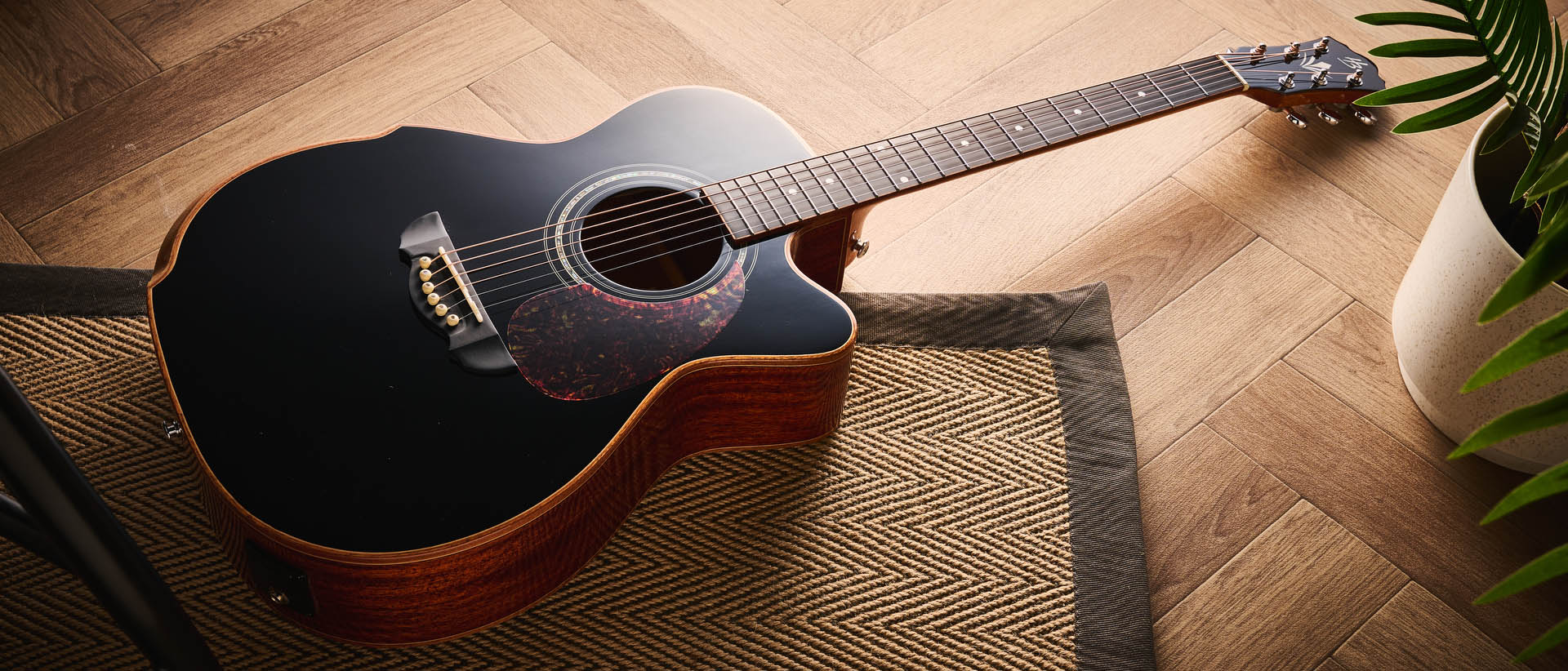Jason Richardson on his love of Alexi Laiho, soundtracking Lifetime movies and how his late pet pug's progressive drinking habits shaped his new album
The virtuosic guitar ace dives deep on II, his blistering new full-length with drummer Luke Holland, taking inspiration from Nintendo and horror blockbuster It

It's not for nothing that progressive shredder Jason Richardson named the lead-off track on his latest album Tendinitis.
Pulled from II – his second full-length collaboration with metalcore drummer Luke Holland – the piece begins deceptively chill, vis-à-vis a sustained orchestral swell and a few of Richardson’s own bluesy, clean-channel musings.
About a minute in, though, he rips into a relentlessly shreddy, tendons-tearing sequence with his fretting hand, at least until his right mitt goes on the offensive with piercing, gun-turret precision. The song gives you phantom pains just hearing it.
“I’ve had it twice in both arms,” Richardson confirms with Guitar World when asked about the song’s namesake affliction. He further explains the piece was titled by prolific YouTube riffer Jared Dines.
While it’s a hell of a workout – on par, Richardson admits, with a particularly ache-inducing, outsized arpeggio section within the new record’s p00mbachu – he also says it’s been quite some time since his limbs have seized up that painfully.
“I’m more conscious about it now, obviously. That was when I was relentlessly working out six days a week, playing video games, constantly using my phone and touring way more because that was [before] Covid. Everything would add up, and I wasn’t stretching enough. It’s terrible, because the only thing you can do is let it rest and take anti-inflammatories every now and then.”
It's been six years since Richardson and Holland first hooked up for their debut collaboration, I.
All the latest guitar news, interviews, lessons, reviews, deals and more, direct to your inbox!
The delay between releases, however, had more to do with Richardson’s schedule filling up once he transitioned into his lead guitarist role with All That Remains – following the 2018 death of their founding guitarist, Oli Herbert – and, of course, the pandemic.
During early Covid times, however, Richardson started sketching out II. Eventually, the California-based guitarist took off for Bethesda, Maryland, to track with Taylor Larsen (Periphery, Asking Alexandria) and plot out the settings of his new signature plugin through the producer/engineer’s MixWave company.
Flash-forward shred momentum is no doubt a big part of II, but the guitarist brings a staggering number of stylistic twists to the 11-song collection. The epic, nearly eight-minute p00mbachu alone whizzes through girder-melting thrash, arrhythmia-inducing djent-quakes, sax-assisted smooth jazz and even a micro-blip of vintage Nintendo-style soundscaping.
That’s not to say the album is without its absolutes. When it came to mixing his high-flying leads, for instance, Richardson was often having a blast waggling the stereo balance back and forth.
“I’ve become obsessed with panning lead delays,” he notes enthusiastically, adding that the dizzying technique was affixed to pretty much every major lead on the album. “It gives [the mix] this really huge sound, instead of being right down in the center. It’s ear candy!”
While Richardson was most-often relying on his crimson-coated signature Ernie Ball Cutlass – as well as a low-rolling Abasi eight-string guitar for the record’s chewier grooves – the spikier metal passages of heavy-hitters like II’s sparrow were an homage to the Scythe-swingin’ attack of late Children of Bodom guitarist Alexi Laiho.
Richardson explains that the Finnish player left a profound impact on him as he was starting up on guitar, a feeling he tapped into again for II.
“I started listening to Children of Bodom a ton when Alexi passed away, because they were one of my biggest influences growing up – right along with Dream Theater,” he says.
“I’ve always wanted one of his guitars, even though it's everything I hate: I don’t like pointy, I’m not a big EMG fan, it’s got one knob, it has a locking nut and a Floyd Rose. But when I was growing up, I either wanted one of his or Petrucci’s – and I could only find Petrucci’s in music stores around me.”
As of press time, Richardson was still waiting to hang a custom-order ESP Scythe at home next to his well-worn JP7 [the Laiho model has since been delivered – Ed], but the guitarist nevertheless channeled the feel of the late metal great’s signature on sparrow with what he had on hand.
D00d would drink water in 7/8. It was literally ‘slurp-slurp-slurp-and-DRINK / slurp-slurp-slurp-and-DRINK,’ but every now and then he would do two slurps, or four slurps, before he swallowed – like a measure of 9/8, or something
“That pull-off riff that kicks in with all the orchestrated synth stabs? Bodom used that all the time. That’s why I put that in there,” he says of the track, which also found him pushing his trem system to string-flopping extremes. “I put the whammy bar down as low as I could possibly get it to go… just to see if it would work. It’s actually disgustingly heavy, and kind of hilarious.”
Beyond Richardson’s extra-nasty imprint, II boasts plenty of other impressive performances. Most obvious is Holland’s heavy-fracking thud, but II also finds Polyphia mastermind Tim Henson running through a graceful section of hybrid-picked fluidity on the record’s closing, Stranger Things-inspired Upside Down.
Arguably most impressive, however, is the percussive backbone of Polyrhythmic Pug: Richardson’s wrinkly-muzzed, but sadly now-departed pet pug, D00d.
“D00d would drink water in 7/8,” Richardson recalls with nostalgic incredulity of the pup, who passed away during the making of II. “It was literally ‘slurp-slurp-slurp-and-DRINK / slurp-slurp-slurp-and-DRINK,’ but every now and then he would do two slurps, or four slurps, before he swallowed – like a measure of 9/8, or something.
“My girlfriend had a video of him drinking, so I took that audio; I barely had to edit it to get it locked into the grid on-time.”
“The song works in contrasts, tone-wise,” he continues. “It starts ignorantly heavy and dark, and then that middle section is really pretty – that’s where you can hear him drinking water in that pattern in the background, with his tags clinking a little bit. I even gave him a writing credit on the album. When you look, it says that song is written by Jason and D00d Richardson.”
p00mbachu is yet another fiercely animalistic moment on II. The genre-mashing tune – its title a portmanteau combining cartoon Lion King character Pumbaa with iconic Pokémon battle beast Pikachu – was a way for Richardson to explore a few different songwriting tangents.
On the one hand, Richardson’s love of Hans Zimmer’s 1994 score to The Lion King left him looking for a way to incorporate the unique ping of a kalimba – an African thumb harp – into his music.
He’d also recently learned how to program the Pokémon battle theme from an old Game Boy game on MIDI, as an ear-training test, which evolved into writing a similarly pulse-quickening electronic motif.
I was listening to Ben Wallfisch’s It soundtrack a ton, and there’s this really atonal part where Pennywise takes the kid down the sewer and bites his arm off. The music to that heavily inspired goodbye...
Richardson and Holland somehow managed to mix those seemingly adverse directions with film noir jazz and blast-intensive metal, making for a head-scratchingly quixotic, though undoubtedly joyful rollercoaster ride.
While often brimming with song-stuffed maximalism, Richardson and Holland’s II offers a bit of breathing room near the back end. behold 2.0 is an instrumental reworking of a tune Richardson had first brought to his former band, Born of Osiris, for their 2011 full-length, Discovery, though now fit with lush haunted house organs and a pinch-squealing guitar performance.
Dialing back the intensity, the ensuing goodbye... revisits the same minor key melody through the distant din of a broken music box and shivers-inducing whistling. The low-key terrorscape, Richardson explains, was in part modeled after the vibe of modern cinema’s most unsettling on-screen clown.
“I was listening to Ben Wallfisch’s It soundtrack a ton, and there’s this really atonal part where Pennywise takes the kid down the sewer and bites his arm off. The music to that heavily inspired goodbye...,” he says. Similar to his stereo-panning lead mixes, Richardson wanted the sound design of goodbye... to mess with your sense of spatial awareness.

“I just wanted something insanely creepy. There are footsteps in there that are supposed to sound like they’re coming from behind you, [and then travel] all the way up to the front… like, you hear the footsteps, then there’s like a rope tying sound, and then you hear a gallows drop. It’s kind of demented, but that horror movie stuff is my shit.”
It’s easy to interpret II as Richardson’s most cinematic effort to date. Even outside of its hyper-specific movie references, II’s daredevil tonal pivots and virtuosic finger gymnastics make for the perfect summer blockbuster.
Richardson’s also contemplating whether or not he should prep a Dolby surround mix of the album to give listeners an even more in-depth presentation of he and Mr. Holland’s latest opus.
On a similar tangent, II may even hint at Richardson’s future working with film. While the guitarist notes it’s a dream of his to start scoring movies, he also feels it’s a hard industry to break into, virtuoso skill set be damned. That said, Richardson reveals that he’s also just wrapped up some session work for an upcoming Lifetime thriller.
“I played a shitload of classical guitar,” he teases of his film score debut. “They’d already written [the arrangement], and sent me midi and the pre-pro stuff; I really just figured out how to play it.”
Richardson is restrictively scant on spoilers, but like much of his guitar work, the plot appears to have plenty of dynamic peaks and valleys: “I’m fingerpicking classical stuff, but I did one shred guitar solo for a car chase scene. It was super-fun!”
- Jason Richardson's new album with Luke Holland, II, is out now.
Gregory Adams is a Vancouver-based arts reporter. From metal legends to emerging pop icons to the best of the basement circuit, he’s interviewed musicians across countless genres for nearly two decades, most recently with Guitar World, Bass Player, Revolver, and more – as well as through his independent newsletter, Gut Feeling. This all still blows his mind. He’s a guitar player, generally bouncing hardcore riffs off his ’52 Tele reissue and a dinged-up SG.

